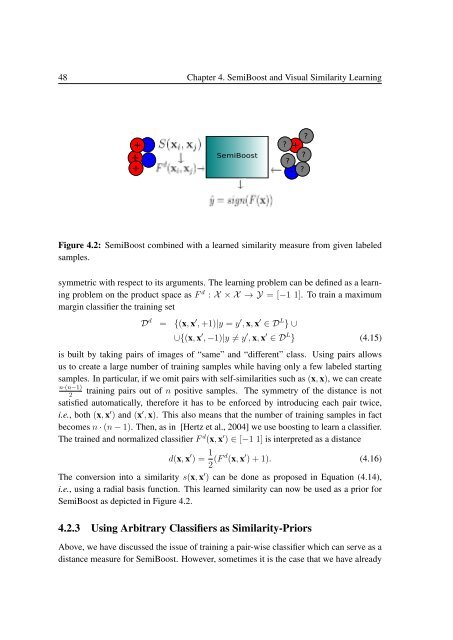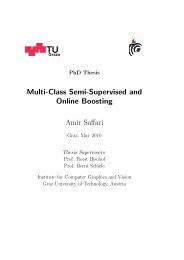PhD Thesis Semi-Supervised Ensemble Methods for Computer Vision
PhD Thesis Semi-Supervised Ensemble Methods for Computer Vision
PhD Thesis Semi-Supervised Ensemble Methods for Computer Vision
Create successful ePaper yourself
Turn your PDF publications into a flip-book with our unique Google optimized e-Paper software.
48 Chapter 4. <strong>Semi</strong>Boost and Visual Similarity Learning<br />
?<br />
+ -<br />
? +<br />
<strong>Semi</strong>Boost<br />
?<br />
+ -<br />
?<br />
+ ?<br />
-<br />
Figure 4.2: <strong>Semi</strong>Boost combined with a learned similarity measure from given labeled<br />
samples.<br />
symmetric with respect to its arguments. The learning problem can be defined as a learning<br />
problem on the product space as F d : X × X → Y = [−1 1]. To train a maximum<br />
margin classifier the training set<br />
D d = {(x, x ′ , +1)|y = y ′ , x, x ′ ∈ D L } ∪<br />
∪{(x, x ′ , −1)|y ≠ y ′ , x, x ′ ∈ D L } (4.15)<br />
is built by taking pairs of images of “same” and “different” class. Using pairs allows<br />
us to create a large number of training samples while having only a few labeled starting<br />
samples. In particular, if we omit pairs with self-similarities such as (x, x), we can create<br />
n·(n−1)<br />
2<br />
training pairs out of n positive samples. The symmetry of the distance is not<br />
satisfied automatically, there<strong>for</strong>e it has to be en<strong>for</strong>ced by introducing each pair twice,<br />
i.e., both (x, x ′ ) and (x ′ , x). This also means that the number of training samples in fact<br />
becomes n · (n − 1). Then, as in [Hertz et al., 2004] we use boosting to learn a classifier.<br />
The trained and normalized classifier F d (x, x ′ ) ∈ [−1 1] is interpreted as a distance<br />
d(x, x ′ ) = 1 2 (F d (x, x ′ ) + 1). (4.16)<br />
The conversion into a similarity s(x, x ′ ) can be done as proposed in Equation (4.14),<br />
i.e., using a radial basis function. This learned similarity can now be used as a prior <strong>for</strong><br />
<strong>Semi</strong>Boost as depicted in Figure 4.2.<br />
4.2.3 Using Arbitrary Classifiers as Similarity-Priors<br />
Above, we have discussed the issue of training a pair-wise classifier which can serve as a<br />
distance measure <strong>for</strong> <strong>Semi</strong>Boost. However, sometimes it is the case that we have already



